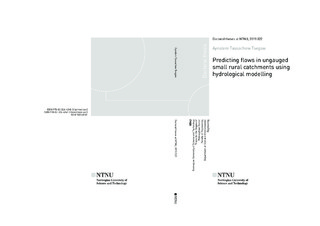| dc.contributor.advisor | Alfredsen, Knut T. | |
| dc.contributor.advisor | Muthanna, Tone Merete | |
| dc.contributor.advisor | Skaugen, Thomas | |
| dc.contributor.author | Tsegaw, Aynalem Tassachew | |
| dc.date.accessioned | 2020-03-04T10:29:41Z | |
| dc.date.available | 2020-03-04T10:29:41Z | |
| dc.date.issued | 2019 | |
| dc.identifier.isbn | 978-82-326-4241-0 | |
| dc.identifier.issn | 1503-8181 | |
| dc.identifier.uri | http://hdl.handle.net/11250/2645157 | |
| dc.description.abstract | Flow data are important information for water resources management such as flood risk management, water utilization, and environmental impact assessment in a changing environment. However, most of the catchments that we are interested in are ungauged which makes a method to predict flow in ungauged catchments an important prerequisite. Reliable estimation of continuous streamflow in ungauged catchments has remained a fundamental challenge in hydrology, although significant insights have been gained in recent years. Flood is the most typical example of natural risk and causes significant economic damage worldwide. Flood risk will become more frequent in the future because of climate and land use changes and may cause increased impacts on human health and economic losses. Growing economic losses are evidence of the increasing intensity of floods draining from small catchments to small watercourses which are usually not sufficiently considered by the flood risk management approaches. Knowledge of hydrological impacts of climate change is essential to aid infrastructure owners in managing the impacts on existing and planned water infrastructures. To provide a meaningful climate impact results at ungauged small rural catchments, it is necessary to use high spatial and temporal resolutions of climate data that can be used to force high resolution hydrological models; however, rainfall-runoff modelling in such catchments is hampered by a lack of both observed discharge and precipitation data and high resolution climate data. To address the challenges of flood risk management, a parsimonious continuous rainfall-runoff model (Distance Distribution Dynamics) with high resolution climate data has been used as the main tool to predict flow and to study impact of climate change; however, the parameters of the model cannot be obtained by calibration on the flow data and hence need to be obtained by regionalization.
The Distance Distribution Dynamics (DDD) model has been regionalized for 41 gauged small rural catchments in Norway (area ≤ 50km2). Three regionalization methods: multiple regression, physical similarity (single-donor and pooling-group based methods) and a combination of the two methods, are used in this study. Seven independent catchments, which are not used in the regionalisation process, are used for validation of the regionalization methods. The combined method (multiple regression and pooling-group type of physical similarity) performs the best of all methods. The DDD model like many other rainfall-runoff models, underestimates floods in many cases in the continuous simulations. To improve the prediction of flood peaks in a continuous simulation, a dynamic river network method is conceptualized and implemented in the DDD model. The method is applied for 15 catchments in Norway and tested on 91 flood peaks. The performance of the method is evaluated using relative errors and mean absolute relative errors and the simulated flood peaks are improved significantly with the method. The mean absolute relative error of the simulated peaks is reduced from 32.9% (without dynamic river networks) to 15.7% (with dynamic river network method). The 0.75 and 0.25 quantiles of the relative errors of the simulated flood peaks are reduced from 41% to 23% and from 22% to 1% respectively. The regionalized DDD model with dynamic river network has been used to study the hydrological impacts of climate change on six ungauged small rural catchments in Bergen area of Norway using a new high-resolution regional climate projection with improved performance with regards to the precipitation distribution. The results show that in the future period (2070-2100), there will be an increase in the mean annual flow compared to the reference period (1981-2011). The maximum increase is 33.3%, and the minimum increase is 16.5%. The mean autumn, winter and spring flows show an increase for the study catchments and contributed significantly for the increase in mean annual flows, but there will be a decrease in the mean summer flows from the study catchments. The maximum decrease in the mean summer flow is 35.2% and the minimum decrease is 7.2%. The results also show that the mean annual maximum flows (floods) increases by 28.9% to 38.3% in the future period. The results of the flood frequency analysis show that there will be an increase of floods (16.1% to 42.7%) with a return periods of 2, 5, 10, 20, 25, 50, 100 and 200 years in small rural catchments at Bergen area of Norway. | nb_NO |
| dc.language.iso | eng | nb_NO |
| dc.publisher | NTNU | nb_NO |
| dc.relation.ispartofseries | Doctoral theses at NTNU;2019:322 | |
| dc.relation.haspart | Paper 1: Tsegaw Tasachew, Aynalem; Alfredsen, Knut; Skaugen, Thomas; Muthanna, Tone Merete. Predicting hourly flows at ungauged small rural catchments using a parsimonious hydrological model. Journal of Hydrology 2019 ;Volum 573. s. 855-871
https://doi.org/10.1016/j.jhydrol.2019.03.090 | nb_NO |
| dc.relation.haspart | Paper 2: Tsegaw, Aynalem Tassachew; Skaugen, Thomas; Alfredsen, Knut; Muthanna, Tone Merete. A dynamic river network method for the prediction of floods using a parsimonious rainfall-runoff model. Hydrology Research 2019
https://doi.org/10.2166/nh.2019.003
- Attribution-NonCommercial-NoDerivatives 4.0 International (CC BY-NC-ND 4.0) | nb_NO |
| dc.relation.haspart | Paper 3: Tsegaw, A.T., Kristvik, Erle, Pontoppidan, M., Alfredsen, K., Muthanna, T. M. Hydrological impacts of climate change on small ungauged catchments-results from a GCM-RCM-hydrologic model chain. | nb_NO |
| dc.title | Predicting flows in ungauged small rural catchments using hydrological modelling | nb_NO |
| dc.type | Doctoral thesis | nb_NO |
| dc.subject.nsi | VDP::Technology: 500::Environmental engineering: 610 | nb_NO |

